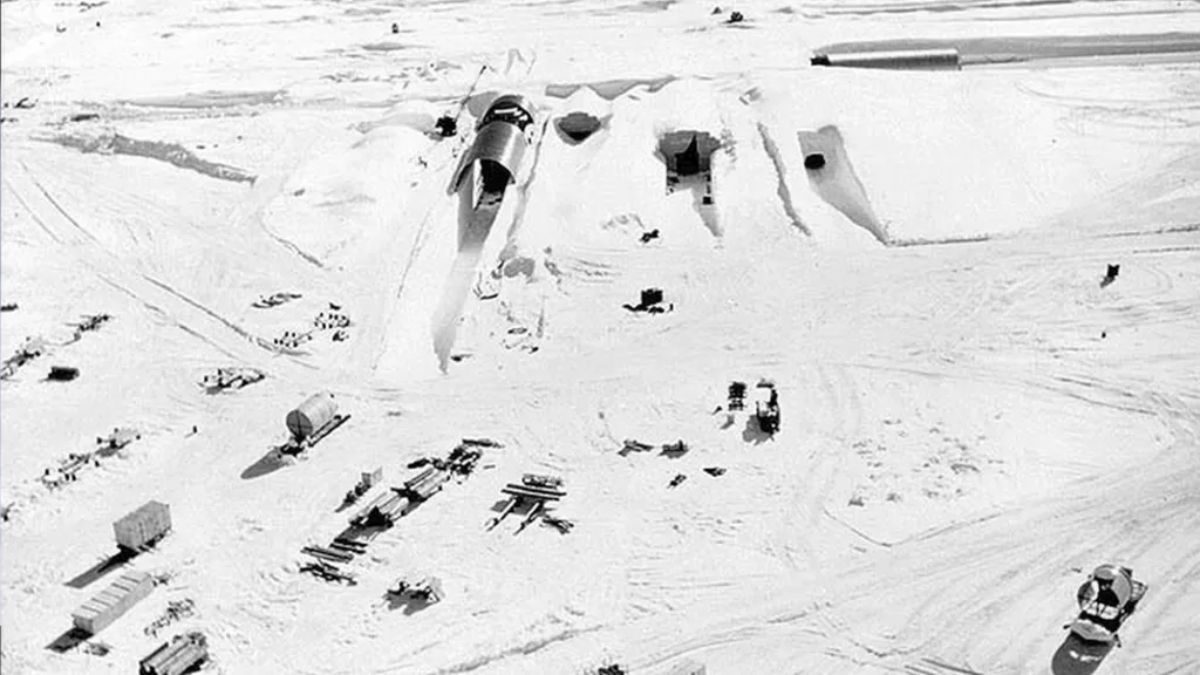The U.S. Nuclear Base Hidden Beneath Greenland's Ice: A Decades-Long Secret

Table of Contents
The Cold War Origins of Camp Century
Camp Century, established in the 1950s under the guise of Arctic research, was in reality a far more ambitious, and clandestine, undertaking. This secret military base, located deep within Greenland's ice sheet, served as a crucial component of Project Iceworm, a Cold War initiative aiming to deploy nuclear missiles across the Arctic. The project, shrouded in secrecy, was designed to exploit the unique characteristics of the Greenland ice sheet as a potential launchpad.
- Location: Camp Century was situated approximately 130 miles northeast of Thule Air Base in northwest Greenland, a strategically vital position.
- Scale and Infrastructure: The base boasted miles of tunnels carved within the ice, housing living quarters, research labs, and support facilities, demonstrating the immense scale of the operation.
- Personnel: Hundreds of military personnel and scientists were stationed at Camp Century during its operational years.
- Technology and Weaponry: Though precise details remain classified, it’s known that Camp Century’s infrastructure was designed to support and potentially deploy nuclear weapons.
The Forgotten Nuclear Waste
The hasty abandonment of Camp Century in 1967 left behind a significant and troubling legacy: a substantial amount of radioactive waste buried within the ice. This includes low-level radioactive waste from power generators and contaminated equipment, alongside other potentially hazardous materials. The discovery has sparked significant concern, primarily due to the accelerating effects of climate change.
- Types of Waste: The waste includes diesel fuel, polychlorinated biphenyls (PCBs), and various radioactive materials, posing a significant threat to the Greenlandic environment.
- Contamination Pathways: As Greenland's ice sheet melts at an alarming rate, there's a growing risk of radioactive contaminants leaching into the surrounding environment, polluting both water sources and the atmosphere.
- Long-Term Effects: The long-term environmental and health consequences of this contamination are still being assessed, but the potential impact on Greenland's fragile ecosystem is extremely serious.
- Responsibility for Cleanup: The responsibility for the cleanup of this hazardous waste remains a contentious issue, sparking debate between the United States and Greenland, highlighting the complex ethical and political dimensions of this Cold War legacy.
Renewed Interest and Scientific Concerns
The accelerating melt of Greenland's ice sheet, driven by climate change, has brought the hidden dangers of Camp Century into stark relief. The increased urgency to assess and mitigate the environmental risks associated with the buried waste has prompted renewed scientific interest and international collaboration.
- Rate of Ice Melt: The increasing rate of ice melt accelerates the potential exposure of the buried waste, creating a time-sensitive challenge.
- Environmental Risk Assessment: Scientists are employing advanced techniques to assess the current state and potential future impact of the waste on the environment.
- International Cooperation: Addressing the challenges posed by Camp Century necessitates collaboration between the United States, Greenland, and other international stakeholders.
- Current Plans: Investigations into the extent of the contamination and the feasibility of remediation efforts are currently underway, though significant challenges remain.
The Ethical and Political Implications
The discovery of Camp Century's legacy raises profound ethical and political questions. Greenland's sovereignty and the right to a clean environment are at the forefront of the discussion. The lack of transparency surrounding the initial establishment and operation of the base highlights a broader concern about accountability for past actions and their long-term environmental consequences. This situation presents a complex scenario, with implications for international relations and the potential for future conflicts regarding environmental justice and resource management in the Arctic.
Conclusion
The story of the hidden U.S. nuclear base beneath Greenland's ice is a stark reminder of the Cold War’s lasting environmental impact and the urgent challenges posed by climate change. The discovery of radioactive waste at Camp Century highlights the need for transparency, accountability, and international cooperation in addressing this critical issue. The melting ice sheet is not only revealing a decades-long secret but also underscoring the increasingly urgent need for environmental remediation and responsible stewardship of the Arctic.
Learn more about the secrets hidden beneath Greenland's ice and investigate the impact of climate change on hidden nuclear waste. Discover the untold story of Camp Century and its environmental legacy. Stay informed about the ongoing developments surrounding this critical issue and its implications for the future of Greenland and the Arctic.

Featured Posts
-
 Kid Cudis Artwork Up For Auction On Joopiter
May 16, 2025
Kid Cudis Artwork Up For Auction On Joopiter
May 16, 2025 -
 Top Dodgers Minor League Players A Look At Kim Hope Miller And Phillips
May 16, 2025
Top Dodgers Minor League Players A Look At Kim Hope Miller And Phillips
May 16, 2025 -
 Xong Hoi Thoi Gian Ly Tuong Va Nhung Dieu Can Biet De Bao Ve Suc Khoe
May 16, 2025
Xong Hoi Thoi Gian Ly Tuong Va Nhung Dieu Can Biet De Bao Ve Suc Khoe
May 16, 2025 -
 Action Bronsons Hilarious Reaction To Jaylen Browns Luke Combs Mix Up
May 16, 2025
Action Bronsons Hilarious Reaction To Jaylen Browns Luke Combs Mix Up
May 16, 2025 -
 Ancelotti Vs Tebas Clash Over Rest For Real Madrid Players
May 16, 2025
Ancelotti Vs Tebas Clash Over Rest For Real Madrid Players
May 16, 2025
